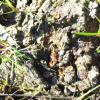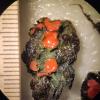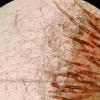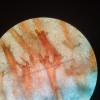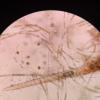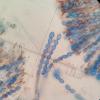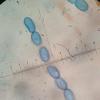
17-12-2025 18:35
 Michel Hairaud
Michel Hairaud
Bonjour à tous/Hi to everyone I am passing along

15-12-2025 15:48
 Danny Newman
Danny Newman
Melanospora cf. lagenaria on old, rotting, fallen

15-12-2025 15:54
 Johan Boonefaes
Johan Boonefaes
Unknown anamorph found on the ground in coastal sa

15-12-2025 21:11
 Hardware Tony
Hardware Tony
Small clavate hairs, negative croziers and IKI bb

15-12-2025 07:09
 Danny Newman
Danny Newman
indet. Rutstroemiaceae sp. on unk. fallen leavesMc

15-12-2025 07:05
 Danny Newman
Danny Newman
Pseudosclerococcum golindoi (det: Zotto)near Cosb

15-12-2025 11:49
 Danny Newman
Danny Newman
ITS sequences from the following two collections B

15-12-2025 12:34
 Danny Newman
Danny Newman
indet. Rhytismataceae on oak leafnear Purchase Roa
coprophilous Scutellinia
Warre Van Caenegem,
14-03-2025 23:29
Apothecia up to 5 mm
Hairs mostly bi- or trifurcated, sometimes simple, up to 600 µm, mostly between 300 and 500 µm, septated, the top of the hairs are hyaline,
Asci 205-240 x (12-)15-16 µm, 8-spored
Ascospores (16-)17-19(-20) x 10-12 µm, with regular spaced, low wrats
Found in Belgium, Antwerp, Mol, on 10 April 2024.
ITS has been sequenced, and matches 97,7% with Scutellinia sp. (Genbank Accession numbers MW540903.1 en MW540937.1), and 96,9% with S. fimicola (MW540964.1). The morphology does not match with S. fimicola, because of the smaller spores and the larger asci.
Are there any other fimicolous Scutellinia species known?
>Scutellinia_ITS
ACCCATCTGCGTACATTACCCGTTGCTTCCGCGAGGCAGTGATCTTCGATCACCTC
CCGACGATGGCTTGGGCCNTCCGGTGGGGAGCCCTCGTGAAAGGTTTACACCAA
ACCCTTGCATTTCTATGTCATCTGTCTGAAACTGTTAATAACAAATGTWAAAACTTT
CAACAACGGATCTCTTGGTTCTCGCATCGATGAAGAACGCAGCGAAATGCGATAA
GTAGTGTGAATTGCAGAATTCAGTGAATCATCGAATCTTTGAACGAACATTGCGCC
TCCTGGTATTCCGGGAGGCATGCCTGTTCGAGCGTCATTAATACCACACTCGAGT
CATTTTCGTGGCTCGGTCTTGGGAGAGGAGCGCAACTCGTCTGCCCTCCCTTCCG
AAATCCAATGGCGGAAAGCCCCACGTGCCCCGGCGTAGTAAGTCTTCTTTCGCTC
GGAACGTTTGGCGATCCTGCCGTGAACCCCCCACAAAATCATTTTACAGGTTGAC
CTCGGATCAGGTAGGGATACCCGCTGAACTTAAGCATA
Malcolm Greaves,
15-03-2025 10:04
Re : coprophilous Scutellinia
In the UK we have had at least 4 species which have been found on dung. Unfortunately none fit your specimen but it shows that at least some of the soil inhabiting species can also grow on dung.
Lothar Krieglsteiner,
15-03-2025 12:08

Re : coprophilous Scutellinia
my hyperborea/minor from the Alps that I want to re-examine soon was growing on cow dung, too.
I was surprised that it was definitely a Scutellinia and not a Cheilymenia.
I was surprised that it was definitely a Scutellinia and not a Cheilymenia.

